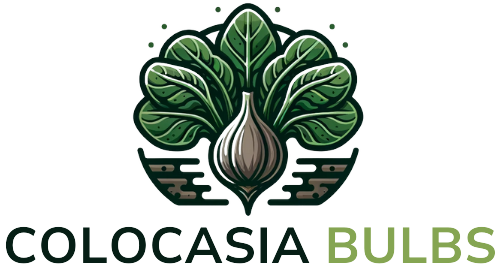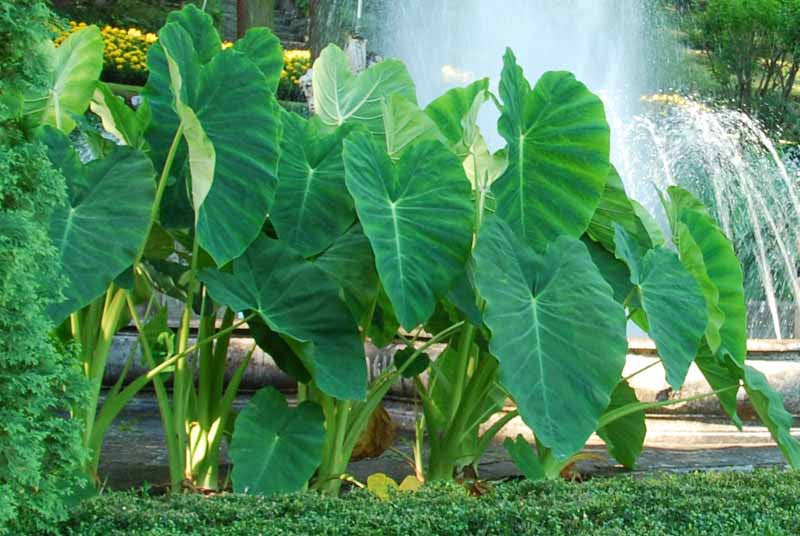(For All Zones, with Special Tips for Zones 8-10: Texas, Florida, Louisiana, Georgia, California, South Carolina, etc.)
Colocasia Gigantea, commonly known as Elephant Ear, is a fast-growing tropical plant that can reach 5-10 feet tall when properly cared for. Whether you live in a warm, frost-free zone or a colder region, this guide will help you grow Colocasia Gigantea from bulbs successfully.
→ Purchase Giant Colocasia Gigantea Bulbs Here
Growing Guide for All Zones
1. Understanding Colocasia Gigantea
- Known for its massive, heart-shaped leaves, often several feet wide.
- Prefers warm, humid environments with ample moisture.
- Can grow in garden beds, large containers, or near ponds.
- Cold-sensitive but can be grown as an annual or overwintered indoors in cold zones.
2. Best Time to Plant (By Zone)
- Zones 8-10: Plant in spring (March-May) when the soil is 65°F or warmer.
- Zones 5-7: Start bulbs indoors 4-6 weeks before the last frost and transplant after all danger of frost has passed.
- Zones 3-4: Grow in containers and move indoors for winter, or treat as an annual.
3. Sunlight Requirements
- Zones 8-10: Thrives in partial shade to full shade; tolerates some morning sun.
- Zones 5-7: Prefers partial shade but can handle more sun in cooler climates.
- Zones 3-4: Needs bright light indoors when overwintering.
4. Soil Preparation
- Needs rich, well-draining soil with high organic content.
- Amend soil with compost or well-rotted manure before planting.
- Avoid heavy clay—mix in sand or perlite for drainage if needed.
5. Planting Instructions
- Plant depth: 2-4 inches deep with the pointed end up.
- Spacing: 3-6 feet apart for full growth.
- Container Growing: Use a large pot (at least 18 inches wide) with drainage holes.
- Water thoroughly after planting to encourage sprouting.
6. Watering Needs
- Zones 8-10: Likes moist, well-watered soil; does well near ponds or in rain-fed areas.
- Zones 5-7: Needs consistent watering, especially in dry spells.
- Zones 3-4: Reduce watering in winter when overwintering indoors.
7. Fertilizing for Maximum Growth
- Heavy feeders – fertilize every 2-3 weeks during the growing season.
- Use a high-nitrogen fertilizer (10-10-10 or 20-10-10) for large, healthy leaves.
- Organic options: Compost, fish emulsion, or manure tea work well.
8. Overwintering & Cold Protection (Zones 3-7)
- Zones 8-10: Plants may survive year-round; mulch for extra protection in Zone 8.
-
Zones 5-7:
- After the first frost, cut back foliage to 4 inches.
- Dig up bulbs, dry for a few days, and store in peat moss or sawdust in a cool, dark place (50-60°F).
- Replant in spring after the last frost.
-
Zones 3-4:
- Grow in containers and bring indoors before temperatures drop below 40°F.
- Place near a sunny window and reduce watering in winter dormancy.
9. Common Problems & Solutions
Yellow Leaves?
- Too much water or too little nitrogen – adjust watering and fertilize.
Pests (Aphids, Spider Mites)?
- Spray with neem oil or insecticidal soap.
Slow Growth?
- Ensure warm temperatures, bright light, and consistent watering.
10. Companion Planting Ideas
- For shady beds: Pair with ferns, hostas, and caladiums.
- For tropical appeal: Plant alongside cannas, bananas, or bird of paradise.
- For bright contrast: Use impatiens or begonias for pops of color.
Final Thoughts
By following this guide, you can successfully grow Colocasia Gigantea no matter your zone. Whether in the ground, a container, or a pond, these impressive, fast-growing plants will bring a dramatic tropical feel to any space.
→ Purchase Your Colocasia Bulbs Here and get started today!


